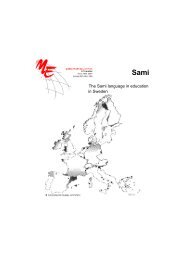Multilingual Early Language Transmission (MELT) - Mercator ...
Multilingual Early Language Transmission (MELT) - Mercator ...
Multilingual Early Language Transmission (MELT) - Mercator ...
Create successful ePaper yourself
Turn your PDF publications into a flip-book with our unique Google optimized e-Paper software.
Irish remains as a community language in only in a small number of areas, known as the<br />
Gaeltacht, mainly on the western coast. In Census 2006, 70.8% (64,265) of the population of<br />
these communities reported that they could speak Irish, but only 57% (36,846) of them<br />
reported that they spoke Irish daily, pointing to a perilously low number of daily speakers<br />
even in supposedly Irish speaking communities. A recent analysis of Irish use in Gaeltacht<br />
areas (Ó Giollagáin et al., 2007) projects that Irish is likely to remain a home/community<br />
language there for at most another twenty years, unless major policy changes are<br />
implemented. Ó Riagáin (2001) attributed the increase in the rate of language shift in the<br />
Gaeltacht to a decline in the number of marriages between fluent speakers, and a reduction<br />
in the number of parents with high ability in Irish who have children with similarly high level<br />
of Irish in recent decades. The best indicator of home-generated Irish ability is found in the<br />
figures for 3-4 year olds in Gaeltacht areas, and in Census 2006, 51% of this age group were<br />
returned as ‘able to speak Irish’ (although only 42% were reported to speak Irish on a daily<br />
basis). Clearly there is a great deal of variability in language use in the home, which means<br />
that children who begin to attend naíonraí or pre-schools in these areas may come as fluent<br />
Irish speakers, as bilinguals with some proficency in both languages, or as English speakers<br />
beginning to acquire Irish. As a result, there is a high level of language contact from a very<br />
young age between these two languages of very unequal status: A survey of Gaeltacht<br />
naíonraí (Hickey, 1999) found that children from Irish-only homes (L1 Irish speakers) were in<br />
the majority in only 20% of naíonraí in these areas, while children from English-only homes<br />
(L2 learners of Irish) were in the majority in 40% of these groups, the remainder having a<br />
majority of children from homes where both Irish and English are spoken.<br />
Thus, while the majority of children attending immersion preschooling in Ireland are being<br />
exposed to Irish as their L2 as part of a revitalisation effort, as in the classic model of<br />
immersion education, immersion preschools in Ireland also play a part in minority language<br />
maintenance in catering for the minority of children who acquire Irish in their home, either<br />
as their only language, or bilingually. In this case, parents are opting for a preschool service<br />
that uses these minority language children's home language as the medium of instruction, in<br />
order to support and extend it before they are exposed to the majority/community<br />
language, as a basis for later bilingualism. In Ireland, as in other countries such as Wales, the<br />
Basque Country and New Zealand, such monolingual minority language preschools are part<br />
of language revitalisation movements aiming to develop bilingualism through consolidating<br />
the non-dominant language in young native-speakers before it is overwhelmed by the<br />
majority language, as well as helping L2 learners to acquire it. The need to support<br />
threatened home languages arises because of erosion of domains of use, limited numbers of<br />
speakers outside the home, and variations in parental proficiency and input. These pressures<br />
can affect children’s cognitive and academic development, and preschool education through<br />
the minority language offers important support to help such children, not only to develop<br />
their mother-tongue, but also their cognitive skills through that language, and to form peer<br />
group networks through the minority language, which help to prevent marginalisation and<br />
low self-esteem. However, given the numbers and the geographical distribution, it is<br />
generally not possible to provide separate groups for children who are acquiring Irish as their<br />
L2 from those whose L1 is Irish, as discussed in Hickey (2005, 2007). Such grouping of L1 and<br />
L2 minority language speakers together poses particular challenges for teachers and teacher<br />
training, and some of the issues concerned with best practice in this regard will be<br />
considered here.<br />
102



